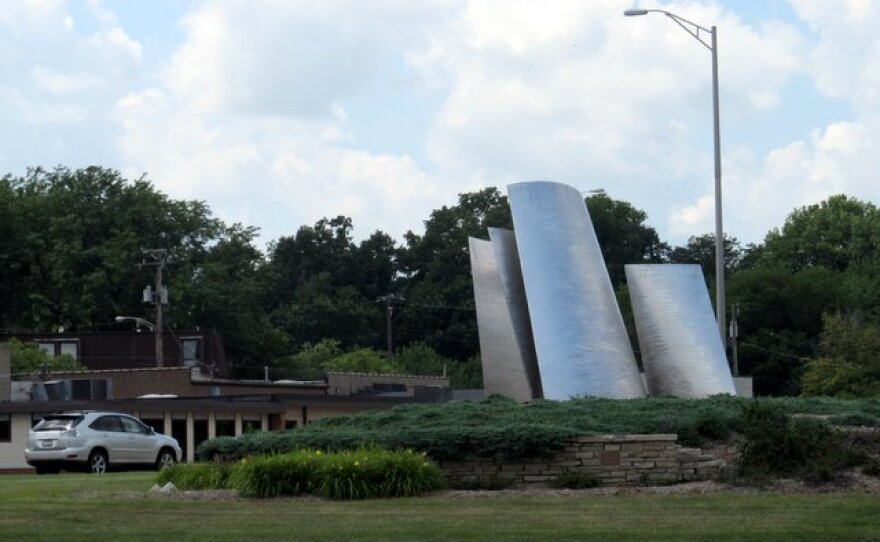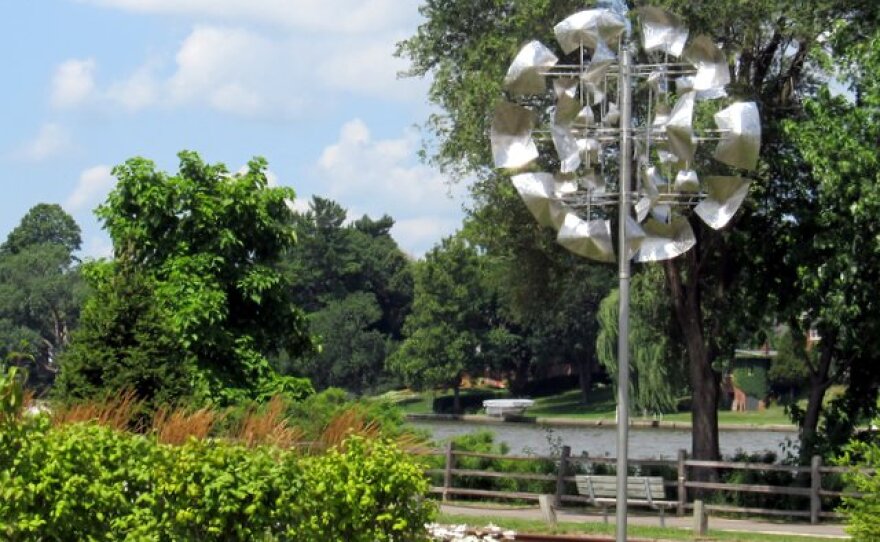You don’t always have to step inside a museum to enjoy art in northern Illinois. Chicago has its Picasso, the Lincoln Highway has its murals, and Rockford has its Symbol. We wrap up our outdoor art series this morning with a walk along the Rock River Recreation Path to visit Rockford’s most controversial sculpture.
Every day, runners, joggers, dog-walkers, bicyclists, and folks just out for a short stroll pass right by one of the region’s most impressive collections of outdoor sculptures. Sixteen massive works of art inhabit a mile-long stretch of the recreation path tucked next to the Rock River just north of the city’s downtown.
On Thursday mornings, from May to September, the Rockford Park District offers its award-winning Arts in the Parks Walking Tour. It's free to anyone who shows up at the starting point: the art-rich Nicholas Conservatory and Gardens. On THIS day, with temperatures pushing one hundred degrees, the only person braving the weather is tour guide Jim McDowell. He wisely changes it from a walking tour to a golf cart ride. He tells the story of Terese Agnew’s “Rock Men Guardians” and Gene Horvath’s “Sinnissippi Crab” and “Suspended Motion” (as well as growing up with Horvath as his neighbor). He reveals the former life of O.V. Shaffer’s “Dancers” (they used to welcome shoppers to the parking lots of Cherryvale Mall in Cherry Valley) and how easy it is to clean Robert Mangold’s whirling silvery “Anemotive Kinetic.” McDowell shows off his favorite (J. Seward Johnson’s “Sight Seeing”) and mine (Robert McCauley’s “Inlet Markers”).
Then he whips the stretch golf cart into the long, cooling shadows of the park’s best-known sculpture: Symbol.
Symbol. The four-story, bright orange, gravity-defying, 30-ton balancing act. The iconic iron structure by famed sculptor, painter, and magazine editor Alexander Liberman turns 35 this year. And it has been a rough 35 years for Symbol. It was designed FOR Rockford, and built IN Rockford, for $117, 216, to be exact…money raised by arts supporters who donated it to the city. But in 1978, at its original location, crowded into the extremely unpopular downtown mall, Symbol suffered from a bad case of wrong place, wrong time.
Symbol was the patsy, becoming the symbol of a dead business district, the symbol of division, the symbol of waste. John McNamara was mayor of Rockford at that time. To him, Symbol’s initial bad impression on the citizens can be squarely blamed on the mall-area’s blocked-off streets.
“It was one more barrier between the east and west sides. You crossed the river and got to Wyman Street and AHHH!”
Eventually, McNamara and his city council decided to rip out one section of the mall, reopening the east-west roadway…leaving Symbol homeless. The massive work that Alexander Liberman had seen as “a symbol for renewal and hope” was dismantled and left to rust in an empty lot by the river.
One Rockford alderman even went as far as suggesting the city’s public works department finish the job and bulldoze the pile of steel cylinders into the Rock River.
Doc Slafkosky was one of the Rockford residents spurred into action by the looming arts travesty.
“What would that have said about us as a city?!?”
Slafkosky says it was a milestone in the history of the creative world in Rockford: before Symbol, there was never a grand public discussion about art in Rockford. After Symbol, everyone was talking about art…good or bad.
In the end, Symbol fans won out over the scrappers. Mayor John McNamara cast the tie-breaking vote, and city council approved Symbol’s move to its current spot along the busy bike path.
The location was perfect for Kevin Schwitters. He was born in Rockford around the same time as Symbol. He only remembers it in the park, and as something big, bright, and fun.
“I thought it was a water slide or a playground. I always asked my mom if we could stop and play on it.”
Then, Schwitters got a little older and realized the big bright orange thing was a work of art. Eventually, he built a website about Symbol when he was pursuing his teaching degree. And he’s surprised: first, that his school project is pretty popular in internet searches. Second, that so many people his age still have automatic negative reactions to Symbol.
“They think it’s silly, it’s ugly, it doesn’t fit. I found it interesting because of lot of the cynicism and attitudes about Symbol mirror attitudes about living in Rockford in general. I like living in Rockford, always have. Some people feel that if Rockford has it, it can’t be good art. That’s silly. It plays into that self-deprecating sense of the city.”
Doc Slafkosky says Symbol is a great representation of Rockford: it’s a great symbol for Rockford because it’s convoluted, it’s misunderstood…just like his city. Slafkosky is co-owner of J.R. Kortman Center for Design, a gallery and shop in downtown Rockford. He also travels the world as a flight crew member for Delta Airlines. He says he often finds himself in the role of ambassador for his hometown…and has recently started carrying a little two-dimensional version of Symbol with him. To Slafkosky, it’s an urban icon, Rockford’s Eiffel Tower, a way to represent and promote the city to people in China, Germany, Italy, Japan…and even in Rockford. Symbol is becoming a social media star, posing in famous places all over the world. And Slafkosky is getting a little obsessed with his role as photographer. He’s spending a lot of time artfully placing his tiny Symbol mock-up next to some of the most important art and architecture, or an abandoned stuffed animal, or in the hands of another tourist who doesn’t speak his language. Then he posts the pictures on his gallery’s Facebook page. They’re fun…and they serve another purpose.
“If we treat it as a sculpture, that’s nice. If we treat it as a symbol of the city, it’s great. It’s something people can wrap their minds around…and their cameras. If you see something on a postcard, in a magazine, it’s thrilling to see it in person!”
That orangey icon is now on bookends, mugs, clocks, ornaments, t-shirts, and postcards. Slafkosky says his biggest seller is anything with the image of a sock monkey (another symbol of Rockford) swinging from Symbol. He’s also working on getting the image on buttons and shot glasses, two inexpensive things people just like to collect.
So it’s about tourism and community pride. John McNamara says he’d like to see the city spend more time marketing a positive image, like the abundance of public art.
“Nothing can speak to this better to me than the river, the art, and free. Everybody’s welcome and everyone can come. No barriers. Cost, transportation, everything else. Everybody can come.”
Seattle is one of the many cities that capitalize on outdoor sculpture. In fact, many a Rockford resident visiting the Space Needle has been stopped cold by the sight of a big, red Symbol lookalike. Liberman created his largest work, Olympic Iliad, in 1984…the year Symbol moved to the Rec Path. And maybe that’s what it takes…seeing that your city has a lot in common with the big, cooler cities. English teacher Kevin Schwitters wants his students to understand that Symbol, and all it represents, is one of the good and interesting things about Rockford.
“Art has value, whether it’s in Rockford, Seattle, or New York City, or wherever.”
Maybe all Symbol needs is a good coat of paint. One of the most common complaints about it is that it’s ORANGE. Not for long. By the end of next month, the park district plans to spend a few overnights painting Symbol, restoring it to its original color: a bright, glossy shade known as Liberman Red.

















